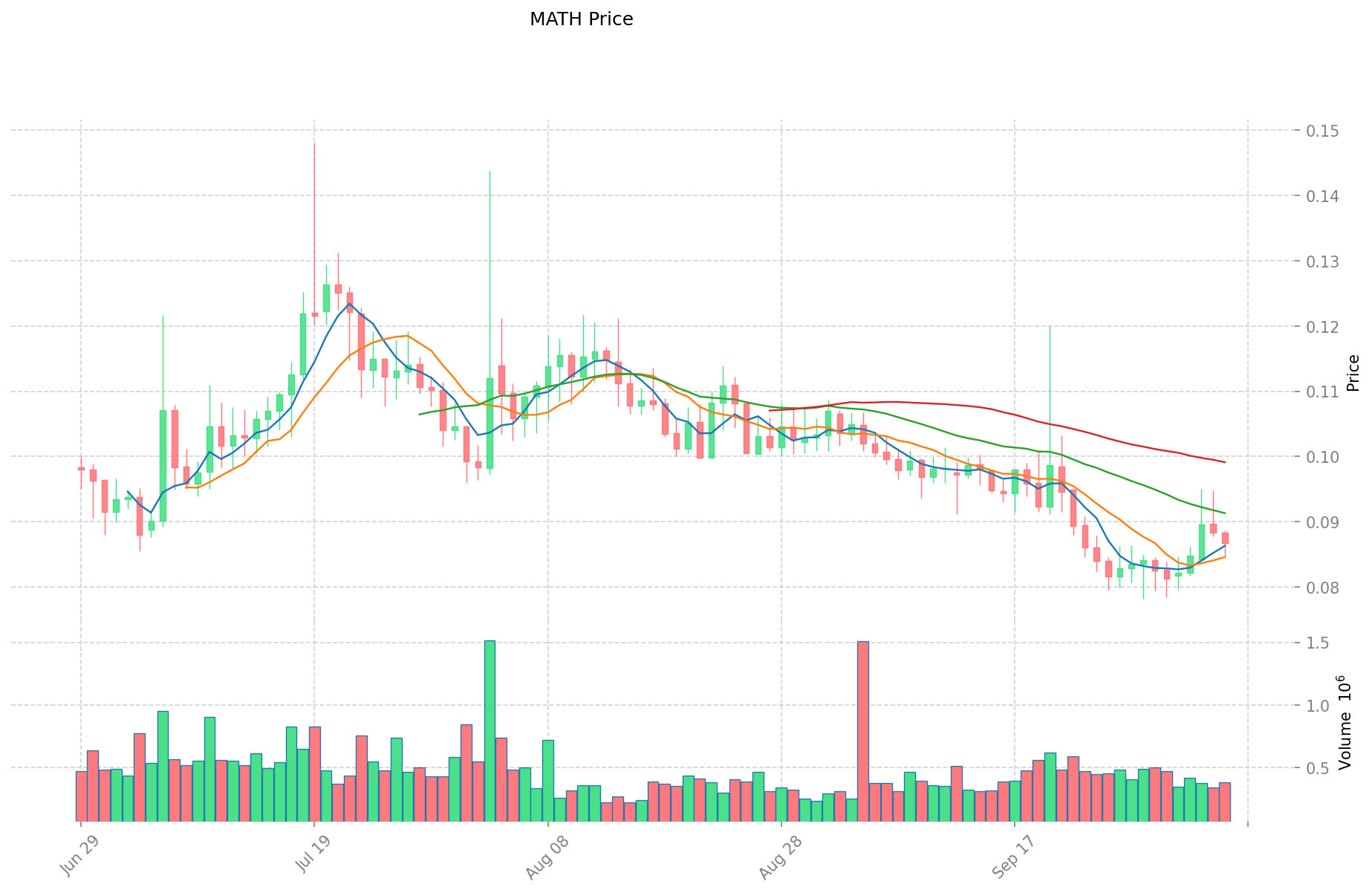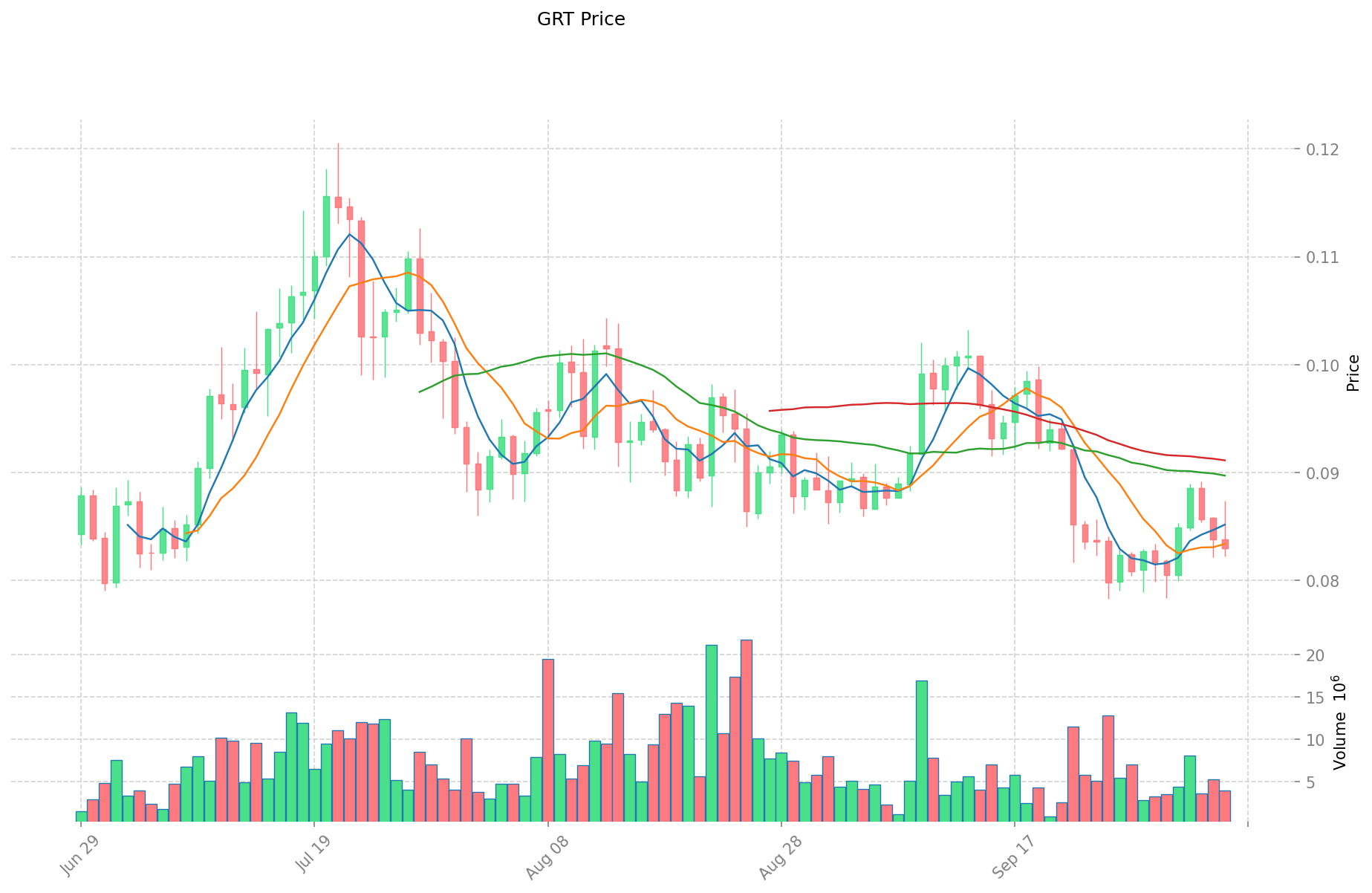MATH vs GRT: Comparing Different Approaches to Algorithmic Problem Solving in Advanced Mathematics
Introduction: Investment Comparison of MATH vs GRT
In the cryptocurrency market, the comparison between MATH vs GRT has always been an unavoidable topic for investors. The two not only show significant differences in market cap ranking, application scenarios, and price performance but also represent different positioning in the crypto asset space.
MATH (MATH): Since its launch in 2020, it has gained market recognition as a one-stop solution platform for digital open finance.
The Graph (GRT): Introduced in 2020, it has been hailed as a decentralized protocol for indexing and querying blockchain data, particularly applied to Ethereum.
This article will comprehensively analyze the investment value comparison between MATH vs GRT, focusing on historical price trends, supply mechanisms, institutional adoption, technical ecosystems, and future predictions, attempting to answer the question investors care about most:
"Which is the better buy right now?"
I. Price History Comparison and Current Market Status
MATH and GRT Historical Price Trends
- 2021: MATH reached its all-time high of $3.15 on March 21, 2021.
- 2021: GRT reached its all-time high of $2.84 on February 12, 2021.
- Comparative analysis: During the 2021 bull market, MATH peaked at $3.15 and dropped to a low of $0.05815, while GRT peaked at $2.84 and fell to a low of $0.052051.
Current Market Situation (2025-10-06)
- MATH current price: $0.0867
- GRT current price: $0.0835
- 24-hour trading volume: $32,991.16 (MATH) vs $369,573.14 (GRT)
- Market Sentiment Index (Fear & Greed Index): 74 (Greed)
Click to view real-time prices:
- Check MATH current price Market Price
- Check GRT current price Market Price


II. Key Factors Affecting MATH vs GRT Investment Value
Supply Mechanism Comparison (Tokenomics)
- MATH: Insufficient information available about the supply mechanism
- GRT: Insufficient information available about the supply mechanism
- 📌 Historical Pattern: Insufficient information about how supply mechanisms drive price cycle changes
Institutional Adoption and Market Applications
- Institutional Holdings: Insufficient information about institutional preferences
- Enterprise Adoption: Insufficient information about applications in cross-border payments, settlements, or portfolio investments
- National Policies: Insufficient information about regulatory attitudes in different countries
Technical Development and Ecosystem Building
- Technical Innovation: Both MATH and GRT appear to have some level of technical innovation, though specific details are not provided
- Market Demand: The success of both tokens depends on actual application of their technology and market response
- Competitive Advantage: Competitive strength appears to be an important factor for both tokens, though specific advantages are not detailed
Macroeconomic and Market Cycles
- Performance in Inflationary Environments: Insufficient information about anti-inflation properties
- Macroeconomic Monetary Policy: Insufficient information about effects of interest rates or dollar index
- Geopolitical Factors: Insufficient information about cross-border transaction demands or international situations
III. 2025-2030 Price Prediction: MATH vs GRT
Short-term Forecast (2025)
- MATH: Conservative $0.048552 - $0.0867 | Optimistic $0.0867 - $0.105774
- GRT: Conservative $0.0423555 - $0.08305 | Optimistic $0.08305 - $0.0971685
Mid-term Forecast (2027)
- MATH may enter a growth phase, with expected price range $0.0966604428 - $0.1465497036
- GRT may enter a steady growth phase, with expected price range $0.065914916375 - $0.1064055078625
- Key drivers: Institutional capital inflow, ETF developments, ecosystem growth
Long-term Forecast (2030)
- MATH: Base scenario $0.1508549909031 - $0.221756836627557 | Optimistic scenario $0.221756836627557+
- GRT: Base scenario $0.117483686611396 - $0.170351345586525 | Optimistic scenario $0.170351345586525+
Disclaimer: This forecast is for informational purposes only and should not be considered as financial advice. Cryptocurrency markets are highly volatile and unpredictable. Always conduct your own research before making any investment decisions.
MATH:
| 年份 | 预测最高价 | 预测平均价格 | 预测最低价 | 涨跌幅 |
|---|---|---|---|---|
| 2025 | 0.105774 | 0.0867 | 0.048552 | 0 |
| 2026 | 0.11163492 | 0.096237 | 0.05196798 | 11 |
| 2027 | 0.1465497036 | 0.10393596 | 0.0966604428 | 19 |
| 2028 | 0.149038969842 | 0.1252428318 | 0.091427267214 | 44 |
| 2029 | 0.1645690809852 | 0.137140900821 | 0.12479821974711 | 58 |
| 2030 | 0.221756836627557 | 0.1508549909031 | 0.076936045360581 | 73 |
GRT:
| 年份 | 预测最高价 | 预测平均价格 | 预测最低价 | 涨跌幅 |
|---|---|---|---|---|
| 2025 | 0.0971685 | 0.08305 | 0.0423555 | 0 |
| 2026 | 0.0982190825 | 0.09010925 | 0.08650488 | 7 |
| 2027 | 0.1064055078625 | 0.09416416625 | 0.065914916375 | 12 |
| 2028 | 0.1203418044675 | 0.10028483705625 | 0.065185144086562 | 20 |
| 2029 | 0.124654052460918 | 0.110313320761875 | 0.092663189439975 | 32 |
| 2030 | 0.170351345586525 | 0.117483686611396 | 0.066965701368496 | 40 |
IV. Investment Strategy Comparison: MATH vs GRT
Long-term vs Short-term Investment Strategies
- MATH: Suitable for investors focusing on digital open finance solutions
- GRT: Suitable for investors interested in blockchain data indexing and querying
Risk Management and Asset Allocation
- Conservative investors: MATH: 40% vs GRT: 60%
- Aggressive investors: MATH: 60% vs GRT: 40%
- Hedging tools: Stablecoin allocation, options, cross-currency portfolios
V. Potential Risk Comparison
Market Risk
- MATH: Volatility in the digital open finance sector
- GRT: Fluctuations in demand for blockchain data indexing services
Technical Risk
- MATH: Scalability, network stability
- GRT: Network congestion, potential vulnerabilities in indexing protocol
Regulatory Risk
- Global regulatory policies may impact both tokens differently, particularly in the areas of DeFi and data management
VI. Conclusion: Which Is the Better Buy?
📌 Investment Value Summary:
- MATH advantages: One-stop solution for digital open finance
- GRT advantages: Decentralized protocol for indexing and querying blockchain data
✅ Investment Advice:
- New investors: Consider a balanced approach, leaning towards GRT for its more established use case
- Experienced investors: Evaluate both based on personal risk tolerance and belief in respective technologies
- Institutional investors: Assess both tokens' potential in relation to broader blockchain and DeFi trends
⚠️ Risk Warning: The cryptocurrency market is highly volatile. This article does not constitute investment advice. None
VII. FAQ
Q1: What are the main differences between MATH and GRT? A: MATH is a one-stop solution platform for digital open finance, while GRT is a decentralized protocol for indexing and querying blockchain data, particularly applied to Ethereum.
Q2: Which token has shown better price performance historically? A: Both tokens reached their all-time highs in early 2021, with MATH peaking at $3.15 and GRT at $2.84. However, as of 2025-10-06, MATH is trading slightly higher at $0.0867 compared to GRT at $0.0835.
Q3: How do the trading volumes of MATH and GRT compare? A: GRT has significantly higher trading volume. As of the current data, GRT's 24-hour trading volume is $369,573.14, while MATH's is $32,991.16.
Q4: What are the long-term price predictions for MATH and GRT? A: For 2030, MATH's base scenario is predicted to be $0.1508549909031 - $0.221756836627557, while GRT's is $0.117483686611396 - $0.170351345586525.
Q5: How should investors allocate their portfolio between MATH and GRT? A: For conservative investors, a suggested allocation is 40% MATH and 60% GRT. For aggressive investors, the suggestion is 60% MATH and 40% GRT.
Q6: What are the main risks associated with investing in MATH and GRT? A: Both tokens face market risks related to their specific sectors, technical risks such as scalability and network stability, and regulatory risks due to potential changes in global policies affecting DeFi and data management.
Q7: Which token might be better for new investors? A: New investors might consider leaning towards GRT due to its more established use case in blockchain data indexing and querying. However, a balanced approach considering both tokens is recommended based on individual risk tolerance and belief in the respective technologies.
Share
Content